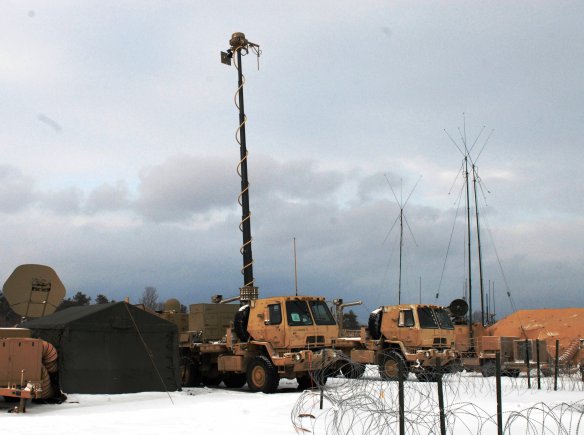
By Claire Heininger
FORT DRUM, N.Y. (April 8, 2013) — As the 3rd Brigade Combat Team, 10th Mountain Division (Light Infantry) prepares for potential deployment with the Army’s new tactical communications network, a recent training exercise marked a key step in increasing unit proficiency and network performance, leaders said.
Built around battalion operations and platoon-level live fire scenarios, the Spartan Peak event used the Capability Set (CS) 13 network to connect dismounted infantry Soldiers with the rest of the brigade more than 25 kilometers away. On the move inside tactical vehicles, leaders used voice and digital connections to exchange information and collaborate on a common operational picture as they executed their mission sets.

A Soldier from the 3rd Brigade Combat Team, 10th Mountain Division, boards a Mine Resistant Ambush Protected (MRAP)- All Terrain Vehicle (M-ATV) equipped with Capability Set 13 network equipment during the brigade’s Spartan Peak field exercise in late March 2013 at Fort Drum, N.Y. The purpose of the week-long exercise was to synchronize the brigade’s Capability Set 13 assets throughout each of the battalions, as well as certifying platoon-level leadership in combined arms live fires. (Photos by Sgt. Javier S. Amador, 10th Mountain Division)
“We really started to utilize the systems to do what they’re intended to do,” said Maj. Graham Wood, the chief communications officer for the brigade, known as 3/10. “We made some large strides.”
The unit is the Army’s second brigade to field and train with CS 13, an advanced, mobile communications network that represents a significant upgrade over capabilities available in theater today. The integrated package of satellite-based systems, data radios, handheld devices and the latest mission command software “unties” commanders from fixed locations and greatly enhances communications for small units at lower echelons.
On one dismounted patrol during Spartan Peak, a platoon carrying lightweight data radios and smartphone-like handheld devices shared situational awareness as they spread out to pursue an objective. Soldiers sent text messages, plotted icons to show enemy locations and drew routes on their screens that were broadcast to their teammates in real time. Trailed by vehicles equipped with other elements of CS 13, the information was relayed back to higher headquarters for quick, informed decisions.
that’s a tremendous capability right there,” Wood said.

Vehicles equipped with Capability Set 13 network equipment are deployed during the Spartan Peak field exercise in late March 2013 for the 3rd Brigade Combat Team, 10th Mountain Division at Fort Drum, N.Y. The purpose of the weeklong exercise was to synchronize the brigade’s Capability Set 13 assets throughout each of the battalions, as well as certifying platoon-level leadership in combined arms live fires.
“The company command post could actually track the movements of the dismounts, as well as the platoon leaders in their trucks tracking the dismounts,” said 1st Lt. Christopher Wilk, communications officer for 3/10’s 1st Battalion, 32nd Infantry Regiment. “When they have a pre-set objective, everyone can see it and have that common operational picture together — and now they can do that on the move, on foot.”
The more hands-on experience Soldiers gain applying CS 13 during mission scenarios — after previously using the gear in the classroom and the motor pool — the more expertise and enthusiasm they develop about what the new technologies can do to support them, leaders said.
“The sheer amount of systems is a big challenge,” Wilk said. “Once they started doing the on-the-job training with the equipment, they’re getting pretty excited about the capabilities they have.”
Next up for 3/10 is re-organizing into a Security Forces Advise and Assist Team (SFAAT), a formation that if called upon to deploy will be charged with working closely with Afghan National Security Forces (ANSF) to improve their capabilities and help the ANSF take on increasing responsibility for the security of their country. While the Afghan forces will be taking a lead in operations, the SFAAT units will have the network capabilities to support with situational awareness and needs such as calls for air support, artillery support and other reach-back communications. The Army has prioritized delivering CS 13 to SFAAT brigades to meet those requirements.
“As you’re looking at having these small teams out there, you’ve got another way to talk back to higher (headquarters) to request assistance — that’s a tremendous capability right there,” Wood said.

A Humvee from the 3rd Brigade Combat Team, 10th Mountain Division at Fort Drum, N.Y., is deployed with its communications satellite dish during the brigade’s Spartan Peak field exercise in late March 2013. The purpose of the weeklong exercise was to synchronize the brigade’s Capability Set 13 assets throughout each of the battalions, as well as certifying platoon-level leadership in combined arms live fires.
At the same time as the SFAAT reorganization, the unit will continue its intensive training regimen. The Mountain Peak exercise scheduled to take place at Fort Drum, N.Y., later this month will challenge the network to pass additional data during brigade-level operations. Mountain Peak will be followed by a Joint Readiness Training Center (JRTC) rotation at Fort Polk, La, which will pose SFAAT scenarios with role players acting as host nation army, police, civilians and enemy insurgents. Recently, the 4th BCT, 10th Mountain Division concluded its own JRTC rotation as the first unit to utilize CS 13 in the SFAAT mission.
Throughout the fielding and training process for CS 13, which began last October, the two brigades have been exchanging ideas, lessons-learned, troubleshooting information, and tactics, techniques and procedures (TTPs) for the CS 13 technologies. Signal officers in particular have collaborated and worked around the clock to master the different components, and are gratified to see their time and effort pay off as they conduct operations in the field.
“You don’t really see everything until you get out of college and go into a career,” said Capt. Jesse Ellis, commander of Charlie Company, 3rd Brigade Special Troops Battalion. “Now they see they own something. They see it coming together.”







